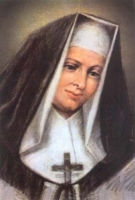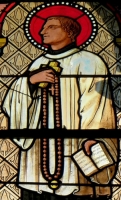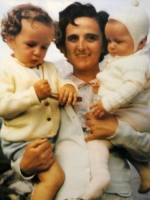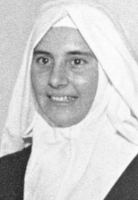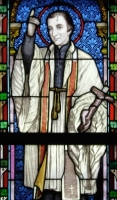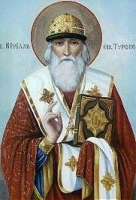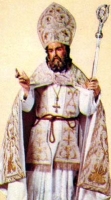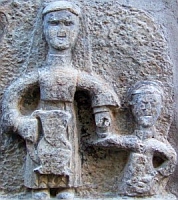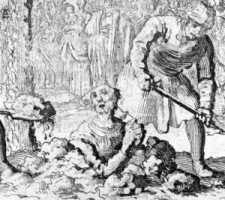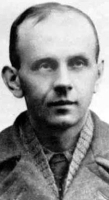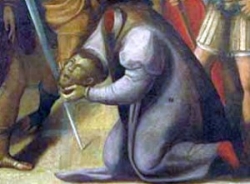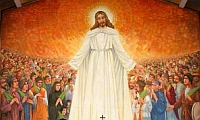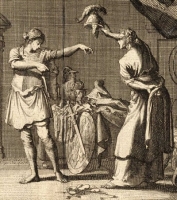St. Agapius
Feastday: April 29
Death: 259
Martyr and probably a bishop, caught up in the persecutions of Emperor Valerian. Agapius and a companion, Secundus, by tradition Spaniards, were exiled by the Romans to Africa. There they were martyred with Emilian, Tertulla, Antonia, and others at Citra.
Bl. Robert Bruges
Feastday: April 29
Death: 1157
Cistercian abbot, also called Robert Gruthhysen. He was born in Burges, Belgium, and entered the Cistercians. In 1311, he went to Clairvaux, France, where St. Bernard of Clairvaux established the framed community. Eight years later, he was sent to his native region where he served as abbot of the monastery at Dunes. In 1153, he received the honor of succeeding St. Bernard as abbot of Clairvaux.
St. Robert of Molesmes
Feastday: April 29
Birth: 1029
Death: 1111
Benedictine abbot and reformer and the founder of the abbey of Citeaux, France, which became the motherhouse of the great monastic order of the Cistercians. A native of Troyes, he was born to noble parents in Champagne. At the age of fifteen, he entered the Benedictine Abbey of Moutier la Celle, near Troyes, where he became prior and abbot of Saint Michael de Tonnere in 1068. He attempted to introduce extensive reforms to the community but met with such resistance that he retired in 1071 and returned to Moutier la Celle. Soon after, a group of hermits in the forest of Collan petitioned Robert to become their head. At first he declined, but the monks persevered and, after winning papal approval for their community, they convinced Robert to accept. In 1074, Robert moved the hermits into the monastery he established at Molesmes. Within a few years, Molesmes grew in size and wealth, and with the prosperity came laxity of discipline. Robert tried without success to resist, and so resigned, going to the hermitage at Or. Though recalled, he remained only until 1098 when he stepped down once more in the face of obdurate resistance by the monks to reinstate full monastic rigor. After winning permission, Robert left with twenty one monks and founded a new community at Citeaux on March 21, 1098. Called by Robert the Novum Monasterium, Citeaux was established with the invaluable aid of Eudes II, duke of Burgundy, and soon acquired much fame for the depth of its spirituality. Much chastened, the monks of Molesmes petitioned to have Robert returned to them. As its abbot once more, Robert turned Molesmes into a leading center for reform, while Citeaux became the heart of the Cistercian order. Robert died as abbot of Molesmes; this was soon extended to the Universal Chruch.
Robert of Molesme (1028 – 17 April 1111) was an abbot, one of the founders of the Cistercian Order and is honored as a Christian saint.
Life
Robert was born about 1029, a nobleman from Champagne, a younger son, who entered the Benedictine abbey of Montier-la-Celle near Troyes at age fifteen and rose to the office of prior.[1]
He was made the abbot of Saint Michel-de-Tonnerre around the year 1070, but he soon discovered that the monks were quarrelsome and disobedient, so he returned to Montier-la-Celle.[2]
Meanwhile, two hermits from a group of monks that had settled at Collan went to Rome and asked Pope Gregory VII to give them Robert as their superior. The pope granted their request, and as of 1074 Robert served as their leader. Soon after, Robert moved the small community to Molesme in the valley of Langres in Burgundy. Initially, the establishment consisted of only huts made of branches surrounding a chapel in the forest, dedicated to the Holy Trinity. Molesme Abbey quickly became known for its piety and sanctity, and Robert's reputation as a saintly man grew.[2] It is because of this reputation that in 1082 Bruno of Cologne came to Robert seeking advice. He lived with Robert's community for a time before going on to found the Grande Chartreuse, the first Carthusian monastery.
In 1098 there were 35 dependent priories of Molesme, and other annexes and some priories of nuns. Donors from the surrounding area vied with one another in helping the monks; soon they had more than they needed, slackened their way of life and became tepid.[3] Benefactors sent their children to the abbey for education and other non-monastic activities began to dominate daily life. The vast land holdings they had acquired required a large number of employees. As the community grew increasingly wealthy, it began to attract men seeking entry for the wrong reasons. They caused a division among the brothers, challenging Robert's severity. Robert twice tried to leave Molesme but was ordered back by the Pope.
Cîteaux
Modern icon of the founders of Citeaux Abbey: Saints Robert, Alberic and Stephen Harding venerate the Blessed Virgin Mary
In 1098,[4] Robert and twenty-one of his monks left Molesme with the intention of never returning. Renaud, the viscount of Beaune, gave this group a desolate valley in a deep forest; there they founded Cîteaux Abbey. Stephen Harding and Alberic – two of Robert's monks from Molesme – were pivotal in founding the new house. The archbishop of Lyons, being persuaded that they could not subsist there without the endorsement of an influential churchman, wrote in their favour to Eudo, duke of Burgundy. Eudo paid for the construction they had begun, helped the monks finance their operating expenses and gave them much land and cattle. The bishop of Challons elevated the new monastery to the canonical status of an abbey.
In 1099, the monks of Molesme asked Robert to return and agreed to submit entirely to his interpretation of the Rule of St. Benedict; the local bishop also pressured Robert to return. He agreed and Molesme became a major center for the Benedictines under his tutelage. Albéric was made successor abbot at Cîteaux, with Stephen Harding as prior.
Robert died on 17 April 1111. Pope Honorius III canonized him in 1222. His feast day in the Roman Catholic Church was at first observed on 17 April, later transferred to April 29, and finally combined with the feast of Alberic and Stephen Harding and is observed in our day on 26 January.[2]
The Vie de saint Robert de Molesme was written by Guy, his immediate successor as abbot of Molesme.
Saint Catherine of Siena
† இன்றைய புனிதர் †
(ஏப்ரல் 28)
✠ புனிதர் லூயிஸ் டி மோன்ட்ஃபோர்ட் ✠
(St. Louis de Montfort)
எழுத்தாளர், குரு, ஒப்புரவாளர்:
(Author, Priest and Confessor)
பிறப்பு: ஜனவரி 31, 1673
மான்ட்ஃபோர்ட்-சுர்-மியூ, ஃபிரான்ஸ்
(Montfort-sur-Meu, France)
இறப்பு: ஏப்ரல் 28, 1716 (வயது 43)
செயிண்ட்-லாரன்ட்-சுர்-சாவ்ரே
(Saint-Laurent-sur-Sèvre)
ஏற்கும் சமயம்:
ரோமன் கத்தோலிக்க திருச்சபை
(Roman Catholic Church)
முக்திப்பேறு பட்டம்: கி.பி 1888
திருத்தந்தை பதின்மூன்றாம் லியோ
(Pope Leo XIII)
புனிதர் பட்டம்: ஜூலை 20, 1947
திருத்தந்தை பன்னிரெண்டாம் பயஸ்
(Pope Pius XII)
நினைவுத் திருநாள்: ஏப்ரல் 28
செயின்ட் லூயிஸ் டி மான்ட்ஃபோர்ட் ஒரு ஃபிரெஞ்சு ரோமன் கத்தோலிக்க குருவும், ஒப்புரவாளரும் ஆவார். அவர் வாழ்ந்திருந்த காலத்தில், ஒரு போதகராக அறியப்பட்ட அவர், திருத்தந்தை பதினோராம் கிளெமென்ட் அவர்களால் ஒரு மிஷனரி அப்போஸ்தலராக நியமிக்கப்பட்டார்.
பிரசங்கிக்கவும், போதிக்கவும் செய்திருந்த இவர், பல்வேறு புத்தகங்கள் எழுதவும் நேரம் ஒதுக்கினார். அவர் எழுதிய புத்தகங்கள், பண்டைய கத்தோலிக்க தலைப்புகளாகவும் மாறின. மற்றும், அவை திருத்தந்தையர் பலரின் செல்வாக்கினையும் பெற்றன. ஆசீர்வதிக்கப்பட்ட கன்னி மரியாள் மீதான அவரது குறிப்பிட்ட பக்தியும், மற்றும் ஜெபமாலை ஜெபிக்கும் அவரது வழக்கத்திற்காகவும் மான்ட்ஃபோர்ட் பிரபலமானார்.
அன்னை மரியாளை பற்றின இறையியல் (Mariology) துறையின் ஆரம்பகால எழுத்தாளர்களில் ஒருவராக மான்ட்ஃபோர்ட் கருதப்படுகிறார். அன்னை கன்னி மரியாளின் மீதான பக்திகளைப் பற்றிய அவரது மிகவும் குறிப்பிடத்தக்க படைப்புகள், "ஜெபமாலை ஜெபித்தலின் இரகசியம்" (The Secret of the Rosary) மற்றும் "மரியாளின் மீதான உண்மையான பக்தி" (True Devotion to Mary) ஆகியனவற்றினை உள்ளடக்கியவையாகும்.
ரோமன் கத்தோலிக்க திருச்சபை, திருத்தந்தை பன்னிரெண்டாம் பயஸ் அவர்களால், கி.பி. 1947ம் ஆண்டு, ஜூலை மாதம், 20ம் நாளன்று, மான்ட்ஃபோர்டை புனிதராக அருட்பொழிவு செய்தது. "கியாகோமோ பாரிசினி" (Giacomo Parisini) என்பவரால் உருவாக்கப்பட்ட ஒரு "நிறுவனர்கள் சிலை" தூய பேதுரு பேராலயத்தில் தெற்கு பீடத்தின் மேல் பகுதியில் அமைந்துள்ளது.
இவர், கி.பி. 1673ம் ஆண்டு, "மான்ட்ஃபோர்ட்-சுர்-மியூ' (Montfort-sur-Meu) நகரில் பிறந்தார். இவரது தந்தையின் பெயர், "ஜீன்-பாப்டிஸ்ட்" (Jean-Baptiste) ஆகும். இவரது தாயாரின் பெயர், "ஜீன் ராபர்ட் கிரிக்னியன்" (Jeanne Robert Grignion) ஆகும். இவரது பெற்றோருக்குப் பிறந்த பதினெட்டு குழந்தைகளில், இவர் மூத்த குழந்தை ஆவார். அவரது தந்தை, பத்திரங்களுக்குச் சட்டபூர்வ அங்கீகாரமளிக்கும் ஒரு வழக்கறிஞர் - நோட்டரி (Notary) ஆவார். லூயிஸ்-மேரி தனது குழந்தை பருவத்தையும், சிறுவர் பருவத்தையும், மான்ட்ஃபோர்டிலிருந்து (Montfort) சில கிலோமீட்டர் தொலைவில் உள்ள "இஃபெண்டிக்" (Iffendic) நகரில் கழித்தார். அங்கு அவரது தந்தை ஒரு பண்ணை வாங்கினார். தனது 12 வயதில், ரென்னஸில் (Rennes) உள்ள "செயின்ட் தாமஸ் பெக்கட்டின்" (Jesuit College of St Thomas Becket) இயேசுசபை கல்லூரியில் அனுமதிக்கப்பட்டார். அங்கு அவரது மாமா ஒருவர், பங்குத் தந்தையாக இருந்தார்.
ரென்னஸில் உள்ள செயின்ட் தாமஸ் (St Thomas in Rennes) பள்ளியில், தனது சாதாரண படிப்பின் முடிவில், அவர் தத்துவம் மற்றும் இறையியல் பற்றிய ஆய்வுகளைத் தொடங்கினார். வேறு சில குருக்களின் வழிகாட்டுதலின் கீழ், அவர் ஏழைகளிடையே மறைப்பணிகளை பிரசங்கிக்க தூண்டப்பட்டார். மேலும், அவர் ஆசீர்வதிக்கப்பட்ட அன்னை கன்னி மரியாள் மீதான தனது வலுவான பக்தியை வளர்த்துக் கொள்ளத் தொடங்கினார்.
கி.பி. 1693ம் ஆண்டின் இறுதியில், புகழ்பெற்ற செயிண்ட்-சல்பைஸின் கருத்தரங்கில் (Seminary of Saint-Sulpice) படிப்பதற்காக பாரிஸ் (Paris) நகருக்குச் செல்ல அவருக்கு ஒரு பயனாளி மூலம் வாய்ப்பு கிட்டியது. அவர் பாரிஸுக்கு வந்தபோது, அவரின் பயனாளி அவருக்கு போதுமான பணம் வழங்கவில்லை என்பதை அறிந்துகொண்டார். எனவே அவர் அடுத்தடுத்து பயணிகள் தாங்கும் இல்லம் ஒன்றில் தங்கியிருந்தார். மிகவும் ஏழைகள் மத்தியில் வாழ்ந்தார். இதற்கிடையில் சோர்போன் பல்கலைக்கழகத்தில் (Sorbonne University) இறையியல் விரிவுரைகளுக்கும் சென்றார். இரண்டு வருடங்களுக்கும் குறைவான காலத்திற்குப் பிறகு, அவர் மிகவும் நோய்வாய்ப்பட்டு மருத்துவமனையில் சேர வேண்டியிருந்தது. இரத்தக் கசிவு நோய்க்காக அவர் மருத்துவமனையில் அனுமதிக்கப்பட்டார்.
மருத்துவமனையில் இருந்து வெளிவந்ததும், ஃபிரென்ச் கத்தோலிக்க குருவான "ஜீன்-ஜேக்குவஸ் ஒலியர்" (Jean-Jacques Olier) அவர்களால் நிறுவப்பட்ட, "லிட்டில் செயிண்ட்-சல்பைஸ்" (Little Saint-Sulpice) அவருக்கு ஒரு இடம் ஒதுக்கப்பட்டிருந்ததை அறிந்து ஆச்சரியமுற்றார். அவர் ஜூலை 1695ல் பிரவேசித்தார். அங்கே அவர் நூலகராக நியமிக்கப்பட்டதால், செயிண்ட்-சல்பிஸில் அவர் இருந்த காலத்தில், ஆன்மீகம் மற்றும் குறிப்பாக கிறிஸ்தவ வாழ்க்கையில் அன்னை கன்னி மரியாளின் இடத்தைப் பற்றிய கிடைக்கக்கூடிய பெரும்பாலான படைப்புகளைப் படிக்க அவருக்கு வாய்ப்பளித்தது. இது, பின்னர் புனித ஜெபமாலை ஜெபிப்பதிலும், மற்றும் அவரது புகழ்பெற்ற புத்தகமான, "ஜெபமாலையின் இரகசியம்" (Secret of the Rosary) ஆகியவற்றில் கவனம் செலுத்த வழிவகுத்தது.
கி.பி. 1700ம் ஆண்டு, ஜூன் மாதம், குருத்துவ அருட்பொழிவு பெற்ற இவர், ஃபிரான்ஸ் நாட்டின் நகரான "நாந்தேஸ்" (Nantes) நகருக்கு அனுப்பப்பட்டார். கனடா நாட்டின் "புதிய பிரெஞ்சு காலனி" (New French colony of Canada) ஆகிய வெளிநாட்டு பகுதிகளுக்கு மறைப்பணி பயணங்களுக்குச் செல்வதே அவரது பெரும் விருப்பமாக இருந்தது. ஆனால் அவரது ஆன்மீக இயக்குனர் அதற்கு எதிராக அறிவுறுத்திய காரணத்தால், அவரால் அது இயலாமல் போனது. இந்த காலகட்டத்தின் அவரது கடிதங்கள், பிரசங்கிக்க வாய்ப்பில்லாததால் அவர் விரக்தியடைந்ததைக் காட்டுகிறது.
கி.பி. 1700ம் ஆண்டு, நவம்பர் மாதம், டொமினிக்கன் மூன்றாம் சபையில் இணைந்த இவர், ஜெபமாலை பிரசங்கிக்க மட்டுமல்லாமல், ஜெபமாலை குழுக்களையும் உருவாக்க அனுமதி கேட்டார். ஆசீர்வதிக்கப்பட்ட கன்னி மரியாளின் மதிப்பு, மற்றும் பாதுகாப்பின் கீழே, மறைப்பணிகள் மற்றும் தியானங்களைப் பிரசங்கிக்க சிறு சிறு குருக்களின் அமைப்புகளைத் தொடங்க அவர் பரிசீலிக்கத் தொடங்கினார். இது இறுதியில் (The Missionaries of the Company of Mary) எனும் மறைப்பணி சபை நிறுவனத்தை உருவாக்க வழிவகுத்தது. இந்த நேரத்தில், அவர் மத்திய மேற்கு ஃபிரான்ஸ் நாட்டின், போய்ட்டியர்ஸ் (Poitiers) நகரின் மருத்துவமனையின் சிற்றாலய குருவாக நியமிக்கப்பட்டார். முதலில் அவர் அருளாளர் "மேரி லூயிஸ் டிரிச்செட்"டை (Blessed Marie Louise Trichet) சந்தித்தார். அந்த சந்திப்பு மேரி லூயிஸின் 34 ஆண்டு ஏழைகளுக்கான சேவையின் தொடக்கமாக அமைந்தது.
திருத்தந்தை பதினோராம் கிளமென்ட் (Pope Clement XI) அவர்களிடம், தாம் மேற்கொண்டு என்ன செய்யவேண்டும் என்ற ஆலோசனை கேட்பதற்காக இவர், ரோம் நகர் பயணித்தார். இவரது உண்மையான மறைப்பணிகளை அங்கீகரித்த திருத்தந்தை, ஃபிரான்ஸ் நாட்டில் அதன் பயிற்சிக்கு ஏராளமான வாய்ப்புகள் இருப்பதாக அவரிடம் கூறி, "அப்போஸ்தலிக் மிஷனரி" (Apostolic Missionary) என்ற பட்டத்துடன் அவரை திருப்பி அனுப்பினார்.
மான்ட்ஃபோர்டின் 16 ஆண்டுகால குருத்துவ பணிகள் மற்றும், மெர்வென்ட் குகையிலும் (Cave of Mervent) வனத்தின் அழகுக்கு மத்தியில், மோன்ட்ஃபோர்ட் கிராமத்திற்கு (Village of Montfort) அருகிலுள்ள செயிண்ட் லாசரஸின் துறவற மடத்திலும் (Hermitage of Saint Lazarus), "லா ரோச்செல்"லில் (La Rochelle) உள்ள செயிண்ட் எலோயின் (Hermitage of Saint Eloi) துறவிலும் தனிமையில் சுமார் நான்கு ஆண்டுகாலம் செலவிட்டார்.
கடின உழைப்பு மற்றும் நோயால் சோர்ந்துபோன அவர், இறுதியாக கி.பி. 1716ம் ஆண்டு, ஏப்ரல் மாதம், மேற்கு ஃபிரான்ஸ் நாட்டின், செ'யிண்ட்-லாரன்ட்-சுர்-செவ்ரே" (Saint-Laurent-Sur-Sèvre) நகருக்கு வந்தார். அதுவே அவரது கடைசி மறைப்பணியாக அமைந்தது. இதன் போது, நோய்வாய்ப்பட்ட அவர், அதே ஆண்டு, ஏப்ரல் மாதம், 28ம் நாளன்று, மரித்தார்.
Also known as
• Caterina Benincasa
• Catharine, Katharine
Other Memorial
30 April (Dominicans)
Profile
Youngest of 24 children; her father was a wool-dyer. At the age of seven she had a vision in which Jesus appeared with Peter, Paul, and John; Jesus blessed her, and she consecrated herself to Him. Her parents began making arranged marriages for her when she turned 12, but she refused to co-operate, became a Dominican tertiary at age 15, and spent her time working with the poor and sick, attracting others to work with her. Received a vision in which she was in a mystical marriage with Christ, and the Infant Christ presented her with a wedding ring. Some of her visions drove her to become more involved in public life. Counselor to and correspondent with Pope Gregory XI and Pope Urban VI. Stigmatist in 1375. Lived in Avignon, France in 1376, and then in Rome, Italy from 1378 until her death. Friend of Blessed Raymond of Capua who was also her confessor. Proclaimed Doctor of the Church on 4 October 1970.
Born
25 March 1347 at Siena, Tuscany, Italy
Died
• 29 April 1380 in Rome, Italy of a mysterious and painful illness that came on without notice, and was never properly diagnosed
• buried in the Dominican church of Santa Maria sopra Minerva in Rome
• first funerary monument erected in 1380 by Blessed Raymond of Capua
• relics re-enshrined in 1430
• relics re-enshrined at the high altar of the church in 1466
Canonized
July 1461 by Pope Pius II
Patronage
• against bodily ills
• against fire
• against illness
• against miscarriages
• against sexual temptation
• against sickness
• against temptations
• fire prevention
• firefighters
• nurses
• nursing services
• people ridiculed for their piety
• sick people
• Theta Phi Alpha sorority
• Europe (declared on 1 October 1999 by Pope John Paul II)
• Italy
• 3 dioceses
• Siena, Italy
• Varazze, Italy
Saint Peter Verona
Also known as
• Peter Martyr
• Peter of Verona
• Peter the Martyr
Additional Memorials
• 18 March (Norwegian Primstaven)
• 4 June (translation of relics)
Profile
Son of Catharist heretics. Educated in a Catholic school and at the University of Bologna, Italy. Embraced orthodox Catholicism upon hearing the teaching of Saint Dominic. Became a Dominican at age 16, received into the Order by Saint Dominic. Prior of the Dominican house in Como, Italy. Priest. Noted and inspiring preacher in the Lombard region, he spoke often against the Catharists. Called a "Second Paul" because he turned from heresy and tried to convert his former confreres. Inquisitor for northern Italy c.1234, appointed by Pope Gregory IX. Assigned to preach against Manichaeanism, he evangelized throughout Italy. Murdered by Catharists on the road. Miracle worker.
Born
1205 at Verona, Italy
Died
• struck on the head with an axe, then stabbed through the heart on 6 April 1252 on the road near Milan, Italy
• interred in the mausoleum of the church of Saint Eustorgio, Milan
• miracles reported at his tomb
Canonized
25 March 1253 by Pope Innocent IV
Patronage
• inquisitors
• midwives
• Castelleone di Suasa, Italy
• Verona, Italy, diocese of
• Guaynabo, Puerto Rico
Blessed Hanna Helena Chrzanowska
Profile
Lay woman in the diocese of Kraków, Poland. She was the daughter of Ignacy Chrzanowski, a university professor, and Wanda Szlenkier, and while their industrialist and land-owning families had a tradition of charity, religious involvement at home was low since one side of the family was Catholic, the other Protestant. She attended an Ursuline high school. Helped care for soldiers wounded and injured in the Bolshevik revolution, then began studies at the School of Nursing in Warsaw, Poland in 1920; studied in France on a scholarship, and worked with members of the American Red Cross.
She became a nurse in a time when the profession was not as respected as today, and became a leading light in the field in her region. Instructor of the University School of Nurses and Hygienists in Kraków from 1926 to 1929. Editor of the monthly publication Nurse Poland from 1929 to 1939. Worked to help form the Catholic Association of Polish Nurses in 1937. Member of the Oblates of the Order of Saint Benedict. During World War II, where she lost her father to the concentration camps, Hanna organized nurses for home care in Warsaw, and helped feed and resettle war refugees. Following the war she became head of a nursing home where, in addition to the administrative duties, she cared for the residents and worked with nursing students. Director of the School of Psychiatric Nursing in Kobierzyn, Poland until the Communists closed it. She then moved into nursing the poor and neglected in her own parish. Fought with cancer the final seven years of her life.
Born
7 October 1902 in Warsaw, Poland
Died
29 April 1973 in Kraków, Poland of cancer
Beatified
• 28 April 2018 by Pope Francis
• beatification recognition celebrated in the Sanktuarium Bozego Milosierdzia, Kraków-Lagiewniki, Poland, presided by Cardinal Angelo Amato
Blessed Itala Mela
Also known as
Sister Maria of the Trinity
Profile
Lay woman in the diocese of La Spezia, Italy, the daughter of primary school teachers of indifferent faith. Itala herself fell completely away from the Church following her brother’s death. However, she later had a conversion experience, returned to the Church, and felt a call to religious life. Though she suffered with health problems, she became a Benedictine Oblate of the Abbey of Saint Paul outside the Walls in Rome, Italy. Noted theological writer, known for her depth of understanding of the Trinity as part of the faith.
Born
28 August 1904 in La Spezia, Italy
Died
29 April 1957 in La Spezia, Italy of natural causes
Beatified
• 10 June 2017 by Pope Francis
• beatification recognition celebrated at Piazza Europa, La Spezia, Italy, presided by Cardinal Angelo Amato
Saint Hugh of Cluny
Also known as
• Hugh the Great
• Hugh of Cluni
• Hugh of Semur
• Hugues de Cluny
Profile
Born to the Burgundian nobility. Eldest son of Count Dalmatius of Semur and Aremberge of Vergy. His father wanted him to become a knight and secular leader; his mother was advised of a vision received by a local priest that her son was destined for religious life. When Hugh seemed more inclined to the Church than the hunt, his father sent him to his grand-uncle Hugh, Bishop of Auxerre, France for education. Novice at Cluny Abbey at age 14. Monk at 15 under Saint Odilo. Deacon at 18. Priest at 20. Benedictine. Abbey prior. Elected abbot on 1 January 1049.
Fought lay investiture, simony, and corruption among the clergy. Founded almost 2,000 new houses, led by like-minded religious, in France, Germany, Spain and Italy. Fought against simony at the Council of Rheims in 1049. Participated in the Council of Rome in 1059 that set the method of election of Popes. Presided over the Synod of Toulouse, and participated in the 1063 Council of Rome. Served as peace maker between the Vatican and Henry IV. Advisor to nine Popes.
Born
1024 at Semur, Brionnais, diocese of Autun, France as Hugues de Semur
Died
• 28 April 1109 at Cluny Abbey, France
• miracles reported at his tomb
• most of his relics were destroyed by Huguenots in 1575
Canonized
6 January 1120 by Pope Saint Callistus II
Patronage
against fever
Blessed Acardo of Avranches.
Also known as
Acardo of San Vittore
Profile
Born to the Norman nobility. Educated by the canons of Bridlington, diocese of York, England. Studied in Paris, France. Monk of the monastery of Saint Victor in Paris. Abbot of the house in 1155. Chosen bishop of Séez, France in 1157, but was opposed by King Henry II of England, and Acardo never took his see. Wrote several treatises on living a spiritual life. Bishop of Avranches, France in 1161. His connection to royalty and the court enabled him to obtain benefits for his diocese and all of the Normandy region of France. Would often retire to the Norbertine abbey of La Lucerne-d’Outremer in Normandy whose church he had help found and bless in 1164. Worked to support orthodox theology about Christ against some of the odd notions of the time.
Born
early 12th century in either Normandy, France or Norman-occupied England
Died
• 1172 of natural causes
• buried in the church of the Norbertine abbey of La Lucerne-d’Outremer, Normandy, France
Saint Severus of Naples
Profile
Bishop of Naples, Italy from 363 to 409. Friend of Saint Ambrose of Milan. Built four basilicas and other churches. Miracle worker; he once brought a dead man back to life so he could clear his widow of false accusations by a creditor.
Died
• 409 of natural causes
• buried in the Catacomba di San Severo, Naples, Italy
• relics transferred to the church of San Giorgio Maggiore in Naples prior to 800
• relics transferred to the basilica of San Salvatore in Naples in the 9th century
• relics transferred to the high altar of the cathedral of Naples in 1310
Saint Torpes of Pisa
Also known as
Torpete, Torpetius, Torpè, Torpès, Tropesius, Tropez
Additional Memorial
17 May (translation of relics)
Profile
Martyred in the persecutions of Nero. Nothing else is known for sure, though that never slowed early writers who created lengthy biographies of him. Saint-Tropez, France is named for him.
Died
beheaded c.65 at Pisa, Italy
Patronage
• mariners
• Pisa, Italy
• Saint-Tropez, France
Saint Tychicus
Also known as
Tychichus, Tychikos
Profile
Spiritual student of Saint Paul the Apostle who delivered several of the letters to early churches; many became part of the New Testament. He is described by Paul in the Epistle to the Ephesians as "beloved brother and faithful servant in the Lord", and is believed to have been a deacon. Since we know nothing of him after his work with Paul, many cities claims him as their first bishop.
Born
Asia Minor
Died
1st century
Saint Antonius Kim Song-u
Also known as
• Antonio Kim Song-u
• Gim Seong-u
Profile
Married layman catechist in the apostolic vicariate of Korea who taught new Christians at his home. Martyr.
Born
1795 in Gusan, Gyeonggi-do (in modern South Korea)
Died
strangled on 29 April 1841 in prison at Tangkogae, Seoul (in modern South Korea)
Canonized
6 May 1984 by Pope John Paul II
Saint Endellion of Tregony
Also known as
Endelient, Endelienda
Profile
Daughter of Saint Brychan of Brycheiniog. Sister of Saint Nectan of Hartland.
Born
Cornwall, England
Died
• 6th century of natural causes
• part of her shrine still exists in Saint Endellion, Cornwall, England
Saint Gundebert of Gumber
Profile
Eighth century Frankish courtier. Brother of Saint Nivard. Married to Saint Bertha of Avenay. With Bertha's approval, he separated from her to become a monk. Travelled to Ireland where he was martyred by pagans attacking his monastery.
Born
France
Died
in Ireland
Blessed Robert Gruthuysen
Also known as
Robert of Bruges
Profile
Benedictine cistercian monk in 1131. Spiritual student of Saint Bernard of Clairvaux. First abbot of Dunes Abbey in 1139. Abbot of Clairvaux Abbey in 1153.
Born
Bruges, Belgium
Died
1157 of natural causes
Saint Ava of Denain
Also known as
• Ava of Dinant
• Avia of...
Profile
Niece of King Pepin the Short. Blind as a child, she was miraculously healed by Saint Rainfredis. Nun a Denain, Hainault (in modern Belgium), and later served as its abbess.
Died
c.845
Saint Dichu
Also known as
Dictinus
Profile
Son of an Ulster chieftain, he was a swineherd in his youth. Saint Patrick's first convert in Ireland. Gave Patrick the ground at Saul for his first Irish church.
Born
4th century Irish
Died
5th century in Saul, Ireland of natural causes
Saint Wilfrid the Younger
Also known as
Wilfrith
Profile
Monk at Beverley Abbey. Spiritual student of Saint John of Beverley. Abbot of Beverley. Late in life he retired to live as a monk at Ripon Abbey.
Died
744
Saint Fiachan of Lismore
Also known as
Fiachna, Fianchine, Fiachina, Fianchne
Profile
Monk at Lismore, Ireland. Spiritual student of Saint Carthage the Younger.
Born
Munster, Ireland
Died
7th century
Saint Theoger
Profile
Benedictine monk. Leading supporter of the monastic reform at Hirsau Abbey and the Cluniac reform in general. Abbot of Saint George's Abbey in the Black Forest c.1100.
Died
1120 at Cluny Abbey of natural causes
Saint Paulinus of Brescia
Profile
Bishop of Brescia, Italy c.524.
Died
• c.545
• relics enshrined in the church of San Pietro in Oliveto, Italy
Saint Daniel of Gerona
Profile
Hermit. Martyr.
Born
Asia Minor
Died
9th century in Spain
Saint Senan of Wales
Profile
Seventh century hermit in north Wales.
Abbots of Cluny
Profile
A feast that recognizes the great and saintly early abbots of Cluny Abbey.
• Saint Aymardus of Cluny
• Saint Berno of Cluny
• Saint Hugh of Cluny
• Saint Mayeul
• Saint Odilo of Cluny
• Saint Odo of Cluny
• Saint Peter the Venerable
Martyrs of Corfu
Also known as
• Martyrs of Corcyra
• Seven Holy Thieves
• Seven Holy Robbers
• Seven Robber Saints
Profile
A gang of thieves who converted while in prison, brought to the faith by Saint Jason and Saint Sosipater who were had been imprisoned for evangelizing. When the gang announced their new faith, they were martyred together. They were - Euphrasius, Faustianus, Insischolus, Januarius, Mammius, Marsalius and Saturninus.
Died
boiled in oil and pitch in the 2nd century on the Island of Corcyra (modern Corfu, Greece)









